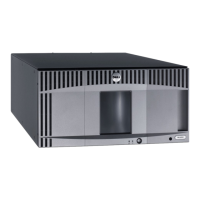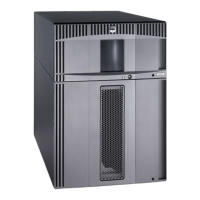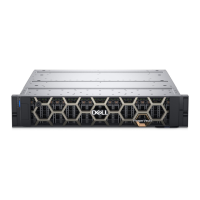Troubleshooting
file:///T|/htdocs/stor-sys/ML6000/en/html/ch09.htm[9/17/2012 1:50:53 PM]
Blade Internal Virtual Port for Medium Changers.
To prevent this, do the following:
• Ensure that host mapping is enabled (see Enabling/Disabling FC Host Mapping).
• Assign each medium changer a unique LUN and map each one to the appropriate host (see
Configuring Host Mapping).
Identifying Tape Drives
You can use the operator panel and the Web client user interfaces to view information about all tape drives installed in the
library. In addition, you can identify tape drives, including the control path tape drive, in selected partitions. The Web client
also allows you to identify tape drives that are not assigned to specific partitions. On the Web client, you can only identify
tape drives that are in a ready state.
The operator panel Drive Information screen lists the following information for each tape drive:
• Control path tape drive status — yes/no
• Vendor
• Model
• Type
• Serial number
• Tape drive firmware version
• Sled boot version
• Sled application version
• Mode status — online/offline, ready/not ready
• Loaded status — unloaded/loaded
• SCSI ID for SCSI tape drives
• World Wide Node Name (WWNN) for Fibre Channel (FC) tape drives
• SAS address for SAS tape drives
The Web client Identify Drives screen lists the following information for each tape drive:
• Location coordinates
• Mode status — online/offline
• State — ready/not ready
• Drive type
• Protocol
• Control path tape drive status — yes/no
• Vendor
• Physical serial number (P-SN)
• Logical serial number (L-SN)
• Tape drive firmware version
Note: Bold column headings in the table can be sorted. For example, selecting the Location column heading will sort
by location coordinates.
On the operator panel Drive Information screen, you can identify the tape drives assigned to the selected partition as well
as the control path tape drive for the partition by flashing the green light-emitting diodes (LEDs) on the back of the tape
drives.
• Use the Identify All button to flash the green LEDs on the back of the tape drives assigned to the partition. The LEDs
blink 10 times per second for one minute.
• Use the Identify Ctrl Path button to flash the green LED on the back of the control path tape drive for the partition.
The control path tape drive is used to connect each partition to the host application. Use this button when you are

